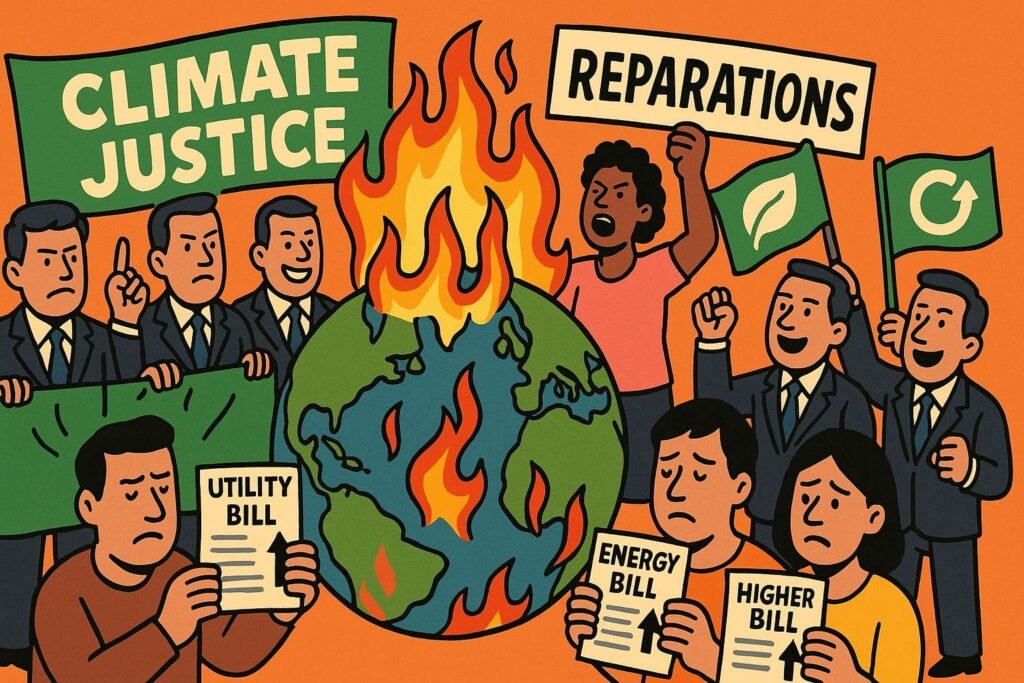Climate Justice – When Saving the Planet Becomes About Power
From Climate Change to Climate Justice
Climate change used to be about science — rising CO₂ levels, melting ice, and seas creeping higher each year. Today, it’s about justice.
Climate Justice reframes global warming as a story of oppression. The villains aren’t just smokestacks or SUVs, but “privileged” groups, wealthy nations, and capitalism itself. The solution isn’t just cutting carbon, but restructuring society.
Climate change is real. But Climate Justice turned it from an environmental challenge into a political weapon — where saving the planet takes a back seat to moral crusades.
Table of contents
Climate Justice Explained
At its core, Climate Justice transforms a scientific problem into a moral one.
- Climate Change: A scientific issue — reduce emissions.
- Climate Justice: A political project — assign guilt, demand reparations, restructure society.
The key question is no longer “How do we cool the planet?” but “Who is guilty, who pays, and who decides the future?”
Core Claims of Climate Justice
The ideology rests on a few recurring premises:
- The rich caused it, the poor suffer it. Western nations are framed as climate criminals.
- Inequality is the real crisis. A flood in New York is nature; a flood in Haiti is oppression.
- Policy must fix social injustice too. Cutting emissions isn’t enough — the economic system itself must be overhauled.
These claims shift climate debates away from solutions and into permanent politics.
Buzzwords to Recognise
Climate Justice has its own marketing dictionary:
- “Climate reparations” – Rich nations must pay poor ones, indefinitely.
- “Climate refugees” – Migration reframed as a moral obligation.
- “Just transition” – Moving away from fossil fuels, bundled with mandatory social engineering.
- “Intersectional climate policy” – Linking race, gender, and sexuality to environmental policy.
These buzzwords aren’t about the weather — they’re about power.
Climate Justice in Action
Climate Justice shows up everywhere once you know the script:
- At the UN: Endless conferences where rich nations pledge money to developing ones — and quietly fail to deliver.
- In Academia: Research papers framing global warming as proof of colonialism.
- On the Streets: Protests aimed less at CO₂ than at capitalism.
- In Corporations: Greenwashed campaigns selling “eco-friendly” products while outsourcing pollution abroad.
The message is clear: climate is no longer just environmental, it’s political.
Why Climate Justice Is Controversial
For activists, it’s the ultimate narrative: every storm, drought, or wildfire can be reframed as injustice.
For politicians, it’s a guilt card: higher taxes, new subsidies, and tighter controls on energy.
For corporations, it’s branding gold: a green leaf logo costs less than raising wages or paying fair taxes.
The problem? The planet keeps heating while elites cash in on “justice.”
The Irony of Climate Justice
What was meant to make climate solutions fairer has created new contradictions:
- The poor still suffer most. Floods in Bangladesh don’t stop because Brussels wrote a justice framework.
- The rich carry on. Davos elites preach about emissions while flying private jets to climate summits.
- The middle class pays. Higher energy bills, new taxes, and lifestyle restrictions — all justified as moral duty.
Climate change is real, but Climate Justice turned it into a marketplace of guilt, branding, and power.
Conclusion: Saving the Planet, or Saving the Narrative?
Climate Justice reframed global warming from a scientific challenge into a political crusade. The focus shifted from reducing CO₂ to restructuring society — with activists, NGOs, corporations, and governments competing for control of the narrative.
The question isn’t whether climate change matters. It’s whether a movement built on branding and blame will ever actually cool the planet.
Next: Trans Studies
FAQ: Climate Justice
What is Climate Justice in simple terms?
It’s the idea that fighting climate change must also fight inequality, turning environmental issues into political struggles.
Why is Climate Justice controversial?
Because it shifts focus from emissions and science to reparations, identity politics, and systemic change.
Who promotes Climate Justice?
Academics, NGOs, UN agencies, and corporations who benefit from turning climate into a permanent activism industry.
What’s the problem with Climate Justice?
It creates endless debate, taxes, and branding exercises — while emissions keep rising.
Doesn’t climate change need action?
Yes — but action doesn’t mean turning every heatwave into a morality play about capitalism.



